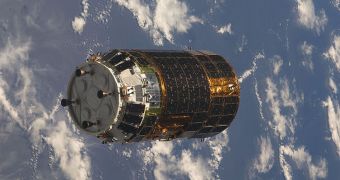According to the flight manifest governing all missions to and from the International Space Station (ISS), the next flight to launch for low-Earth orbit is that of the second H-II Transfer Vehicle, an unmanned cargo delivery spacecraft constructed by JAXA.
The space probe features no automated docking controls of its own, and so astronauts aboard the ISS will need to use the Canadarm2 robotic arm on the station's exterior to grapple it, and lead it towards its destination, the nadir port of the Harmony node.
At this point, the capsule is scheduled to launch at 6:29 UTC on January 20, from the Yoshinobu-2 launch pad at the Tanegashima Space Center, in Japan. HTV-2 will meet up with the ISS on January 27, and will remain docked to the orbital facility until February 24.
The H-IIB Launch Vehicle No. 2 (H-IIB F2) will be used during take-off. The space rocket is manufactured through a collaborative effort of Mitsubishi Heavy Industries (MHI) and the Japan Aerospace Exploration Agency (JAXA).
The new mission is called Kounotori 2, which is Japanese for white stork. The resupply flight will carry in excess of 6,000 kilograms of pressurized and unpressurized cargo to LEO, including food, fuel, water, scientific equipment, spare parts and personal items.
After the six-astronaut crew on the ISS unloads all the cargo the HTV-2 carries to orbit, it will load the container up with thrash, waste material, worn-out clothes and so on. Once the cargo ship separates from the space lab, it will burn up in Earth's atmosphere, its cargo with it.
In anticipation of the mission, which will bring the Japanese spacecraft to the ISS in 20 days, station commander Scott Kelly (NASA) and flight engineers Catherine Coleman (NASA) and Paolo Nespoli (ESA) rehearsed the Canadarm2 procedures they will need to use to capture the capsule.
The team also prepared for the now-uncertain arrival of space shuttle Discovery, which has been grounded on technical difficulties for three months.
When the orbiter does launch – most likely in late February or early March – the ISS crew will need to capture high-resolution photographies of its underbelly. These images will then be sent back to NASA mission control.
Experts here will analyze them, and determine if debris separating from the external fuel tank during launch damages the sensitive ceramic tiles that protect the shuttle during atmospheric reentry.
The other members of the Expedition 26 crew spent their first workdays after New Year's conducting preemptive maintenance task on the ISS' most vital systems, Space Fellowship reports.

 14 DAY TRIAL //
14 DAY TRIAL //